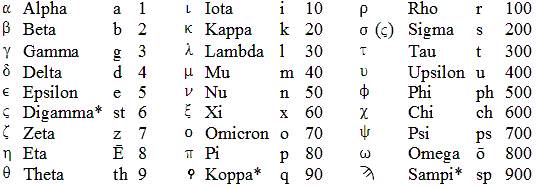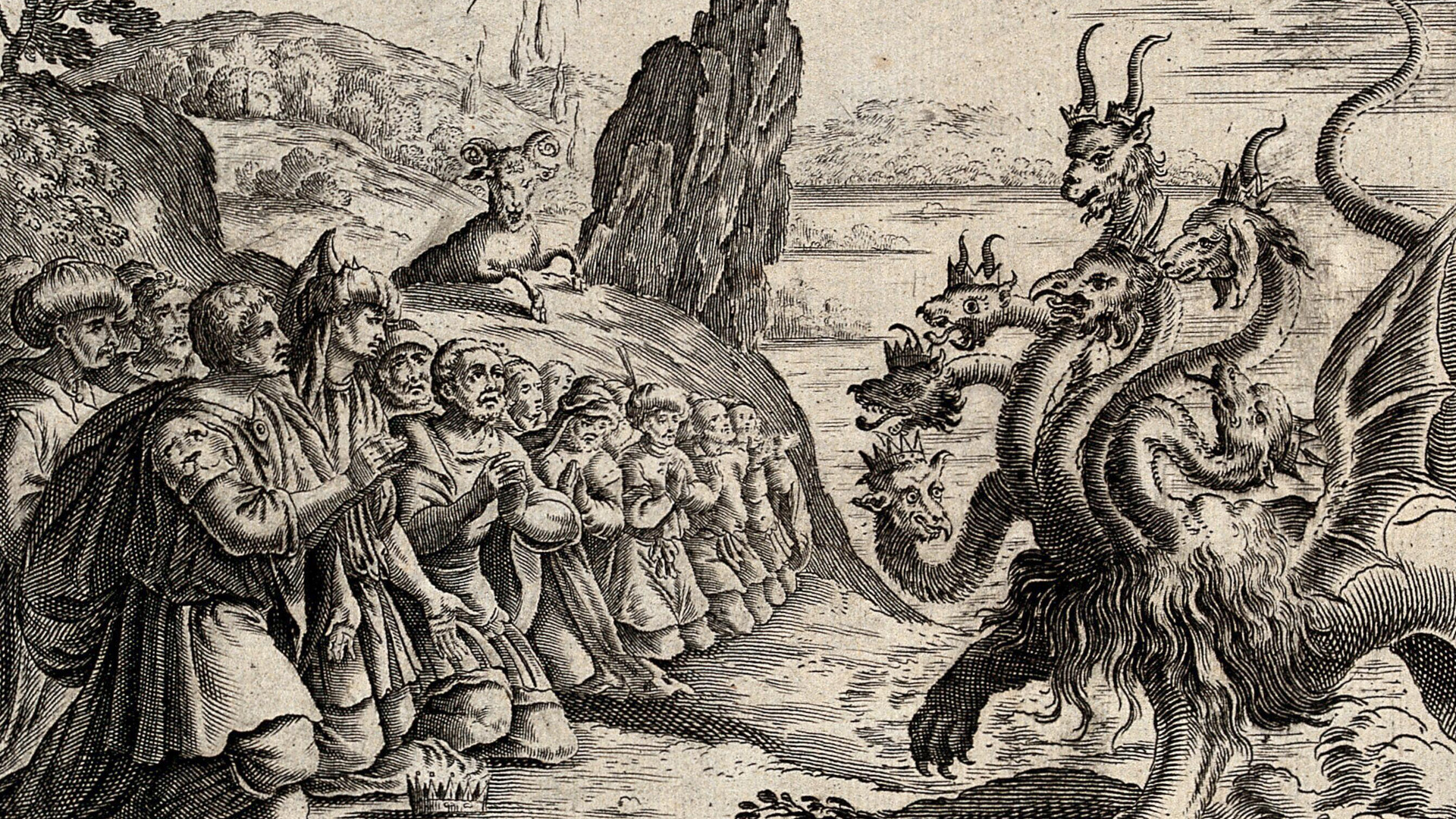You are here
Why Did John State That the Beast’s Number Is 666?

Revelation 13:18
The Know
After being exiled to Patmos, the Apostle John saw a magnificent vision that has since been placed as the last book of the New Testament (see Revelation 1:1). This vision pertains to the historical events of John’s day as well as to the latter days preceding the Second Coming.1 Because John’s vision frequently uses symbolic language and images, its meanings may not always be immediately apparent.
One of the symbolic terms that John employed involves gematria, a Jewish system of thought that assigns “a numerical value to a word or phrase.”2 While this practice may seem odd to modern readers, Richard D. Draper and Michael D. Rhodes point out, “Most ancient people did not have a separate numbering system and alphabet, so letters also served as numbers. … As a result, any given name could be translated into a number.”3 The first letter in Greek and Hebrew, for example, had the numerical value of the number one, and so on (see charts below). By adding up the values for each letter, a wide array of numbers could be achieved.


In Revelation 13, John sees a vision of a dragon and a beast who persecute the Church of God. Regarding the beast, John states, “Here is wisdom. Let him that hath understanding count the number of the beast: for it is the number of a man; and his number is Six hundred threescore and six” (Revelation 13:18). This appears to be an example of a specialized use of gematria called isopsephy, which “is more properly understood as an encoded phrase, name, or idea that is conveyed numerically rather than literally.”4 It is especially apparent that John’s description of 666 is an example of isopsephy, given that it is described as being “the number of a man.” Lincoln H. Blumell and Thomas A. Wayment identify this phrase as “a loosely adaptable formula” to mark isopsephy in a given text.5
Thus, the number can be viewed as an encoded message that John’s audience—especially those with a Jewish background—may have been able to discern. This has also led to many speculations about the identity of this beast by later audiences. “The challenge with [gematria/isopsephy] is that any number of words or names can have the same numerical value, thus leaving uncertain any suggested solution.”6 However, various solutions have been proposed.
One of the most widely accepted theories is that this number refers to Nero, who initiated the first official Roman persecution of the Christian Church. When transliterated into Greek, his name would be Neron Caesar, and when spelled with the Hebrew alphabet, it’s numeric value is 666.7 Interestingly, some early manuscripts of Revelation found in “Latin-speaking areas of the Church” state that the number of the beast is 616.8 This same number (616) occurs when Nero’s Latin name (Nero Caesar) is spelled in Hebrew.
John’s immediate historical setting is relevant to this identification. While many early Christians believed the book of Revelation to have been written during Domitian’s reign in AD 81–96, others believed that it was written a generation earlier during Nero’s reign in AD 54–68, which would make the number’s designation as Nero immediately applicable for John’s time.9
Both Nero and Domitian were famous for their persecution of the Christians. Thus, the designation as a beast persecuting the Church would be an apt title for either emperor. Yet, while the number 666 cannot be easily tracked to Domitian, even if Revelation had been authored during Domitian’s reign, rumors spread throughout the Mediterranean that “Nero did not actually die in AD 68 but had fled to Parthia, where he was raising a huge army to come back and destroy Rome.”10 While Nero ultimately did not return, it could have been a reminder to the Christians of what they had experienced earlier and were experiencing again under Domitian’s reign.
The use of isopsephy in inscriptions regarding Nero has also been attested, allowing the writer to state what he was apparently afraid to say in public. One such inscription reads, “A calculation new: Nero his mother slew.” This isopsephy utilizes the numerical values for the Greek name Nero and the phrase “his mother slew,” giving each phrase in the inscription the numerical equivalent of 1005.11 Given Nero’s persecution against the Christians in Rome, viewing him as a beast that helped the dragon (symbolically understood to be the devil) persecute the Church would have made a lot of sense in the early Christian Church (see Revelation 13:15).
Draper and Rhodes have also presented another hypothesis regarding the meaning of the number, suggesting that it actually refers to the beast itself. When the Greek word for beast (therion) is spelled in Hebrew, the numerical equivalent is 666. By employing this meaning, Draper and Rhodes argue that John “is asking for moral discernment in order to avoid being entrapped by the beast.”12
Furthermore, the number six itself stands in sharp contrast to the number seven, which is used as “God’s number.”13 As such, “Six would then be that which comes the closest to perfection, but misses the mark and falls short of its potential.”14 Repeating this imperfect number three times intensifies the idea of incompleteness and failure while also suggesting “a condition of deep spiritual wickedness.”15
This case may be strengthened when compared with the next part of John’s vision in Revelation 14, which describes hosts of “the 144,000, who carry the seal of Christ on their foreheads (Rev. 14:1).”16 Thus, there is a marked spiritual contrast between these righteous Saints who were sealed “on their foreheads” and those who had been marked by the beast in their right hands and forehead (see Revelation 13:16). When viewed in this symbolic light, the great righteousness of the high priests mentioned in Revelation 14 stands opposite to the multitudes of the wicked who follow the dragon and the beast (see Doctrine and Covenants 77:11).
The Why
Other interpretations have been put forward in an attempt to identify the beast with a variety of people or organizations, although each has various challenges in their interpretation.17 Ultimately the meaning of this number has not been addressed in modern revelation. Because many aspects of the book of Revelation deal not only with John’s time but also with the time immediately preceding the Second Coming, it is possible that the beast and its number could have multiple identifications or fulfillments.
One of the most insightful scriptural texts in relation to the book of Revelation comes from the Book of Mormon. After Nephi saw a vision of his own immediate times and of his people’s future, he saw “one of the twelve apostles of the Lamb” (1 Nephi 14:20). This Apostle, who was identified as John, would “write the remainder of these things; yea, and also many things which have been. And he shall also write concerning the end of the world” (1 Nephi 14:21–22, 27). In other words, John’s writings, according to Nephi, encompass the past, present, and future.
Richard Neitzel Holzapfel and Thomas A. Wayment took this view, stating that “John may have been expressing his understanding that the beast of the latter days would be wicked in some of the ways that Nero was.”18 Thus, an awareness of John’s historical setting, including the Roman persecutions under Nero, may help modern readers identify some of the symbols John employed, including those seemingly targeted against Rome.19
It is important to remember that whatever form of persecution this beast may represent—whether past, present, or future—blessings of peace and protection have been promised to the disciples of Jesus Christ. According to Nephi, “[the Lord] will preserve the righteous by his power, even if it so be that the fulness of his wrath must come, and the righteous be preserved, even unto the destruction of their enemies by fire. … And the righteous need not fear, for they are those who shall not be confounded” (1 Nephi 22:17, 22).
As we continuously rely on Jesus Christ and His Atonement, all will be made right and eventually Christ’s disciples “shall see his face; and his name shall be in their foreheads. And there shall be no night there; and they need no candle, neither light of the sun; for the Lord God giveth them light: and they shall reign for ever and ever” (Revelation 22:4–5).
Further Reading
Richard D. Draper and Michael D. Rhodes, The Revelation of John the Apostle (Provo, UT: BYU Studies, 2013), 330–335.
Lincoln H. Blumell and Thomas A. Wayment, “The ‘Number of the Beast’: Revelation 13:18 and Early Christian Isopsephies,” in Book of Seven Seals: The Peculiarity of Revelation, Its Manuscripts, Attestation, and Transmission, ed. Thomas J. Kraus and Michael Sommer (Tübingen, Germany: Mohr Siebeck, 2016), 119–135.
Richard Neitzel Holzapfel and Thomas A. Wayment, Making Sense of the New Testament: Timely Insights and Timeless Messages (Salt Lake City, UT: Deseret Book, 2010), 510–512.
Donald W. Parry and Jay A. Parry, Understanding the Book of Revelation (Salt Lake City, UT: Deseret Book, 1998), 176–177.
- 1. For a brief overview of early Christian views of the Second Coming, including how these individuals interpreted many passages in Revelation, see Nicholas J. Frederick, “Facing the End: The Second Coming of Jesus Christ and the Millennium,” in Ancient Christians: An Introduction for Latter-day Saints, ed. Jason R. Combs, Mark D. Ellison, Catherine Gines Taylor, and Kristian S. Heal (Provo, UT: Maxwell Institute, 2022), 471–503.
- 2. Richard D. Draper and Michael D. Rhodes, The Revelation of John the Apostle (Provo, UT: BYU Studies, 2013), 332.
- 3. Draper and Rhodes, Revelation of John the Apostle, 332.
- 4. Lincoln H. Blumell and Thomas A. Wayment, “The ‘Number of the Beast’: Revelation 13:18 and Early Christian Isopsephies,” in Book of Seven Seals: The Peculiarity of Revelation, Its Manuscripts, Attestation, and Transmission, ed. Thomas J. Kraus and Michael Sommer (Tübingen, Germany: Mohr Siebeck, 2016), 124n22.
- 5. Blumell and Wayment, “‘Number of the Beast,’” 119; see pages 120–124, 128–134 for additional examples of isopsephy from both Christian and non-Christian writers.
- 6. Draper and Rhodes, Revelation of John the Apostle, 332.
- 7. Although the title Caesar would normally be spelled with a yod in Hebrew as pointed out by Draper and Rhodes, Revelation of John the Apostle, 333, an Aramaic manuscript found at Murabba’at spells Nero’s name (Neron Caesar) without employing the yod. This contemporary source offers support for the proposal that Nero is the referent in Revelation 13:18. See J. Massyngberde Ford, Revelation: A New Translation with Introduction and Commentary (New York, NY: Doubleday, 1975), 226.
- 8. Richard Neitzel Holzapfel and Thomas A. Wayment, Making Sense of the New Testament: Timely Insights and Timeless Messages (Salt Lake City, UT: Deseret Book, 2010), 511.
- 9. Harold W. Attridge, ed., The Harper Collins Study Bible, rev. ed. (San Francisco, CA: HarperOne, 2006), 2086–2087.
- 10. Draper and Rhodes, Revelation of John the Apostle, 333; cf. Attridge, Harper Collins Study Bible, 2086–2087; Blumell and Wayment, “‘Number of the Beast,’” 127.
- 11. Blumell and Wayment, “‘Number of the Beast,’” 121; Ford, Revelation, 226. It is significant that this is the only extant use of isopsephy in reference to a Roman emperor outside of Revelation 13:18.
- 12. Draper and Rhodes, Revelation of John the Apostle, 333–334.
- 13. Draper and Rhodes, Revelation of John the Apostle, 334.
- 14. Draper and Rhodes, Revelation of John the Apostle, 334; cf. Donald W. Parry and Jay A. Parry, Understanding the Book of Revelation (Salt Lake City, UT: Deseret Book, 1998), 176.
- 15. Draper and Rhodes, Revelation of John the Apostle, 334.
- 16. Draper and Rhodes, Revelation of John the Apostle, 334.
- 17. See Draper and Rhodes, Revelation of John the Apostle, 332–334, for an analysis of the various interpretations previously proposed; cf. Parry and Parry, Understanding the Book of Revelation, 176.
- 18. Holzapfel and Wayment, Making Sense of the New Testament, 511.
- 19. For example, in Revelation 17:9 John mentions a woman sitting upon “seven hills,” which was an image used in Roman imagery to depict the city of Rome. See Draper and Rhodes, Revelation of John the Apostle, 414–415. Draper and Rhodes point out that, as with the number of the beast, various interpretations may be meant simultaneously.
KnoWhy Citation
Related KnoWhys
Subscribe
Get the latest updates on Book of Mormon topics and research for free





